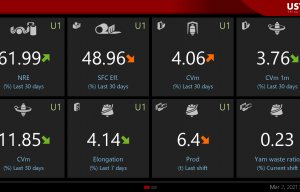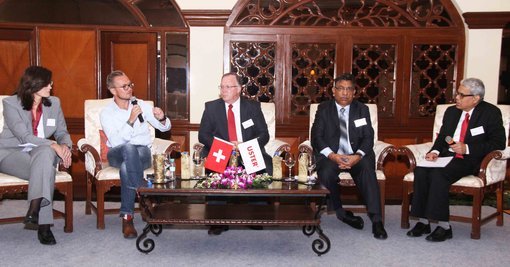
Uster’s innovations in Shanghai
The event attracted 25 high-level participants, including directors and promoters of 25 mills from all over India.

18th February 2016
Innovation in Textiles
|
Uster
The third edition of the Uster Quality University took place from 5-7 February in Goa, where under the leadership of V.R. Rathnam, Head Uster Technologies India, the expert panel delivered a practical and authoritative analysis, revealing some often surprising and challenging requirements for successful yarn production.
The panel comprised of S.K. Khandelia, President, Sutlej Group; Calvin Woolley, Global Supplier Development Leader, Ikea; Iris Biermann, Head of Textile Technology, Uster Technologies; and David McAlister, Product Manager Fiber Testing, Uster Technologies.
The event attracted 25 high-level participants, including directors and promoters of 25 mills from all over India. The theme of the event was Roadmap to the future of the spinning industry in India.
The special event, organised by Uster Technologies, offered a shared experience of top textile executives, market forecasts, valuable business intelligence and an analysis of problems and solutions.
Adaptability, attention to quality issues, value added product mix, sustainable manufacturing and focusing on consumer demands were the key recommendations from a forum of experts.
India’s textile industry is already huge, and still growing, with 50 million spindles installed. And the government has set an ambitious target to boost its share of global textile trade from 5% to 20%. Whether it is a realistic target, how Indian spinning mills are performing today, and what changes they are making in their quest for extra business were the main topics addressed by industry experts.
Leading industry professional Mr Khandelia provided a telling account of the key issues and options for Indian spinners today. His experience as the head of a group of four mills producing 300 tonnes of yarn per day is significant, and he first outlined the problems mills face in adapting to new market trends, the company reports.
This was often restricted, he said, by the existing plant design and set-up, which prevented innovations that did not fit with the mill’s capabilities. However, dramatic solutions could be found, as when, early in his career, he rescued a 200,000-spindle mill earmarked for closure by initiating product diversification instead.
Mr Khandelia emphasized the need for focus in managing the business. For example, he now works with only one daily report, compared to numerous documents and papers in the past. He also concentrates only on deviations from the norm in mill production, rather than checking and analysing good results. “If we can handle the exceptions, it is enough, but we also know that benchmarking against international standards and best practices is a must, to differentiate our company from competitors,” he explained.
Calvin Woolley, the representative of Ikea, the world’s largest furniture retailer, at the Uster Quality University, presented a forecast that India – recently overtaken China as the world’s largest cotton producer – has the potential to be the leader in cotton yarn production too.
Ikea has been sourcing in India for almost 30 years and despite many challenges the company developed suppliers in sustainable compliance what Ikea calls its IWAY. Many Indian mills today also suffer from unreliable energy sources, something which is vital for the value chain in yarn production. Ikea is keen to push renewable energy sources, and reduce dependence on coal.
“Zero coal demand will come. Not now but it will come, and those spinners who are the last to move to renewable energy will be left behind,” said Mr Woolley.
David McAlister, of Uster Technologies, pointed out that mills were now having to operate in a consumer-led marketplace, rather than merely offering up an existing product range to their customers in spinning and weaving.
“Consumers now define the type of products they like and the performance they need,” he said. “It is not possible for a spinning mill to switch overnight from one fibre type to another, but China, for example, had an issue in staying competitive with cotton, so they moved towards synthetics and man-made fibres.”

Business intelligence for the fibre, textiles and apparel industries: technologies, innovations, markets, investments, trade policy, sourcing, strategy...
Find out more